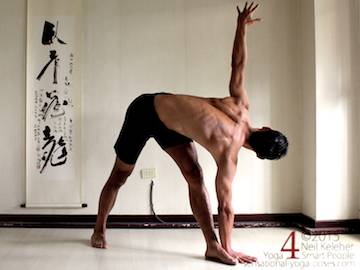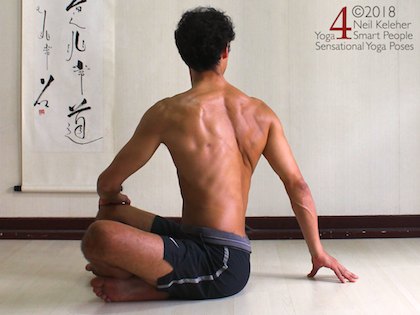Serratus Posterior Inferior
A Potential Anchor for the Lats and a Co-Stabilizer for the Lower Ribcage
I first became familiar with the Serratus posterior inferior muscle after doing a bit of reading about the thoracolumbar fascia.
The serratus posterior inferior is an often talked about part of the thoracolumbar fascia.
It attaches at the back of the ribcage to the lower four ribs. The muscle forms a downward pointing chevron shape whose points attach to the bottom two thoracic vertebrae and the upper two lumbar vertebrae.
Basic Actions of the Serratus Posterior Inferior Muscle
- Acting from the spine this set of muscles creates a downward pull on the bottom four ribs.
- Acting from the ribs it can create an upward and outward pull on the vertebrae, which, if both sides are activated, can help to stabilize this portion of the spine (where the lumbar spine meets the thoracic spine.)
Muscle Control for Stability and Proprioceptive Feedback
Both sides of the muscle could be active in stabilized side bending actions. Moving slowly into a side bent, one side could lengthen but stay active while the other side could shorten and stay active. This sort of dual action can be used not only to maintain stability of the lumbar-thoracic junction but also to create sensation and proprioceptive feedback.
Giving the Serratus Posterior Inferior Room-To-Activate
In order for these muscles to work on the spine it can help to give them operating length. To that end, a first step in using these muscles to stabilize the spine could be to lift the ribs. This could use the intercostal muscles. But it could also use the levator costarum muscles, particularly if the focus is on lifting the backs of the ribs.
In any case lifting the ribs can be used to lengthen the serratus posterior inferior giving them room to contract effectively so that working against each other they can help stabilize the lumbar thoracic spine.
Giving the Latissimus Dorsai An Anchored Attachment Point
The latissimus dorsai, which has portions which are also part of the thoracolumbar fascia, has attachments to the lower three or four ribs.

A depiction of the Latissimus Dorsai muscle showing the muscle attaching to the bottom three ribs.
So that these fibers of the latissimus dorsai can contract effectively, it can help to use the serratus posterior inferior muscles to anchor the bottom four ribs.
To activate the serratus posterior inferior before activating the latissimus dorsai, create a downward pull on the back of the bottom three or four ribs. You may find that in any overhead arm action that uses the lat to pull down the arms, pulling the ribs down first makes it easier to use the arms to pull the hands down or the body up.
Another way in which the latissimus dorsai and serratus posterior inferior can act is across the center line of the body.
The latissimus dorsai has attachments along a considerable portion of the spine. And like the serratus posterior inferior, it too has attachments to the lower two thoracic and upper two lumbar vertebrae.
If one arm is stabilized, either held rigid from muscular tension or braced against a wall or the floor, it can act as a foundation for the same side latissimus dorsai which can then act as an anchor for the spine. This may give the opposite side serratus posterior inferior a foundation from which to act on the lower ribs which, in combination with the anchored spine, give the lats of that side a foundation from which to act on the upper arm.
The serratus posterior inferior could also be used, with the spine as an anchor, to help deepen the twist.
Activating the Serratus Posterior Inferior With a Downwards Pull on the Ribs
In yoga, a pose in which this could be experienced is revolving triangle. Seated yoga twists with the hands on the floor on on a knee may also use this mechanism.
Note that if doing a twist to the right (with or without the help of the arms), you could focus on pulling down on the lower right back ribs. If the focus is on creating a downward pull on these lower back ribs, then the serratus posterior inferior may be activated.
Alleviating Serratus Posterior Inferior Pain
If you get serratus posterior inferior pain in a pose like side angle, one possible solution could be to lift the back ribs on that side giving the PSI room to contract. (For me, it's when doing the pose to the left that I get SPI pain. My right side serratus posterior inferior hurts)
The Upper Transverse Abdominus and the Serratus Posterior Inferior
Interestingly the serratus posterior inferior seems to have a connection and relation to the upper band of the transverse abdominus muscle. The upper transverse abdominus attaches to the ribs, covering the front of the costal arch.
This part of the transverse abdominus pulls inwards on the ribs. So that this part of the transverse abdominus can contract more effectively it may help to lift the ribs. Thus the serratus posterior inferior and the transverse abdominus are both lengthened giving them room to effectively contract.
Co-activation of the upper transverse abdominus and the serratus posterior inferior helps to stabilize the bottom four ribs of the ribcage and in addition it could be used to help protect the solar plexus.
While it is possible to do this latter action in isolation it may also serve to work in unison with mechanisms for stabilizing the middle and lower lumbar spine and sacroiliac joint. It may also work in concert with mechanisms for stabilizing the upper thoracic spine.
Better functioning of all of these systems may be accomplished by practicing using each subsystem in isolation as well as together.
One final note about the serratus posterior inferior is with respect to relative stability of the upper ribcage compared of the lower ribcage.
The upper half of the ribcage is inherently more stable because the upper 7 ribs attach directly to the sternum. The lower half of the ribcage is less stable, in particular becasue of the large inverted u-shape opening (or arch) at the front. The lowest portion (the bottom two ribs) is even less stable.
Snakes, Ostriches and Turtles
The upper portion of the ribcage may be designed to be more stable so that the arms have a more stable base from which to act.
Inspirations for this idea can be gleaned from looking at the skeletons of a snake (no limbs, not sternum), an ostritch or emu, massive wings even if it can't fly and a massive sternum and tortoises, which may have developed shells to give their forelimbs more power for digging.
Having the lower half of the ribcage slightly stable gives it more move-ability. However there may be occasions where it is better of being stabilized, or there may be occasions where stability is required with the lower ribcage in different shapes, to facilitate different body shapes and different actions. Hence the need for the serratus posterior inferior and the upper transverse abdominus to act as lower thoracic stabilizers.
Stabilizing the Junction of the Ribcage and the Lower Back
And as a final reminder, since the posterior serratus posterior inferior crosses the boundary between the thoracic spine and the lumbar spine, it can be used to help stabilize the lumbo-thoracic (or thoraco-lumbar) junction, that point of the spine where the ribcage meets the lower back.
In this capacity, it can work along with the upper band of the transverse abdominis muscle.
Published: 2020 08 28





